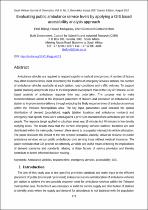 ResearchSpace
ResearchSpace
Evaluating public ambulance service levels by applying a GIS based accessibility analysis approach
JavaScript is disabled for your browser. Some features of this site may not work without it.
- ResearchSpace
- →
- Research Publications/Outputs
- →
- Journal Articles
- →
- View Item
| dc.contributor.author |
Baloyi, Ethel

|
|
| dc.contributor.author |
Mokgalaka, Hunadi M

|
|
| dc.contributor.author |
Green, Chéri A

|
|
| dc.contributor.author |
Mans, Gerbrand G

|
|
| dc.date.accessioned | 2018-02-07T10:34:36Z | |
| dc.date.available | 2018-02-07T10:34:36Z | |
| dc.date.issued | 2017-08 | |
| dc.identifier.citation | Baloyi, E. et al. 2017. Evaluating public ambulance service levels by applying a GIS based accessibility analysis approach. South African Journal of Geomatics, vol. 6(2): 172-183 | en_US |
| dc.identifier.issn | 2225-8531 | |
| dc.identifier.uri | http://www.sajg.org.za/index.php/sajg/article/view/583 | |
| dc.identifier.uri | DOI: http://dx.doi.org/10.4314/sajg.v6i2.3 | |
| dc.identifier.uri | http://hdl.handle.net/10204/10026 | |
| dc.description | This is an open access article published in South African Journal of Geomatics, vol. 6(2): 172-183 | en_US |
| dc.description.abstract | Ambulance vehicles are required to respond rapidly to medical emergencies. A number of factors may affect response times, most importantly the location of emergency services stations, the number of ambulance vehicles available at each station, road conditions and traffic volumes. To support spatial planning and provide input to the Integrated Development Plan of the City of Tshwane, a GIS based analysis of ambulance response time was undertaken. The purpose was to make recommendations aimed at the improved placement of stations and allocation of ambulances per station to improve service delivery through reducing the likely response times of ambulance services within the Tshwane Metropolitan area. The key input parameters used included the spatial distribution of demand (population), supply (station locations and ambulance numbers) and emergency road speeds These were tested against a provision standard of one ambulance per 30 000 people. The response target applied in suburban areas was 15 minutes but 40 minutes in low density outlying areas. The results show that the current emergency services stations’ locations are well distributed within the metropole; however, there seems to be a spatial mismatch in vehicle allocation. The paper discusses the impact of the two demand scenarios, namely: universal reliance on public ambulance services versus public ambulances only serving those without medical insurance. The paper concludes that GIS provide an extremely versatile and useful means of testing the implications of demand scenarios and standards relating to these factors of service provision and thereby contribute to better informed decision making. | en_US |
| dc.language.iso | en | en_US |
| dc.publisher | CONSAS | en_US |
| dc.relation.ispartofseries | Worklist;19629 | |
| dc.subject | Ambulance vehicles | en_US |
| dc.subject | Response time | en_US |
| dc.subject | Emergency services | en_US |
| dc.subject | Accessibility | en_US |
| dc.subject | Geographic Information Systems | en_US |
| dc.subject | GIS | en_US |
| dc.title | Evaluating public ambulance service levels by applying a GIS based accessibility analysis approach | en_US |
| dc.type | Article | en_US |
| dc.identifier.apacitation | Baloyi, E., Mokgalaka, H. M., Green, C. A., & Mans, G. G. (2017). Evaluating public ambulance service levels by applying a GIS based accessibility analysis approach. http://hdl.handle.net/10204/10026 | en_ZA |
| dc.identifier.chicagocitation | Baloyi, Ethel, Hunadi M Mokgalaka, Cheri A Green, and Gerbrand G Mans "Evaluating public ambulance service levels by applying a GIS based accessibility analysis approach." (2017) http://hdl.handle.net/10204/10026 | en_ZA |
| dc.identifier.vancouvercitation | Baloyi E, Mokgalaka HM, Green CA, Mans GG. Evaluating public ambulance service levels by applying a GIS based accessibility analysis approach. 2017; http://hdl.handle.net/10204/10026. | en_ZA |
| dc.identifier.ris | TY - Article AU - Baloyi, Ethel AU - Mokgalaka, Hunadi M AU - Green, Cheri A AU - Mans, Gerbrand G AB - Ambulance vehicles are required to respond rapidly to medical emergencies. A number of factors may affect response times, most importantly the location of emergency services stations, the number of ambulance vehicles available at each station, road conditions and traffic volumes. To support spatial planning and provide input to the Integrated Development Plan of the City of Tshwane, a GIS based analysis of ambulance response time was undertaken. The purpose was to make recommendations aimed at the improved placement of stations and allocation of ambulances per station to improve service delivery through reducing the likely response times of ambulance services within the Tshwane Metropolitan area. The key input parameters used included the spatial distribution of demand (population), supply (station locations and ambulance numbers) and emergency road speeds These were tested against a provision standard of one ambulance per 30 000 people. The response target applied in suburban areas was 15 minutes but 40 minutes in low density outlying areas. The results show that the current emergency services stations’ locations are well distributed within the metropole; however, there seems to be a spatial mismatch in vehicle allocation. The paper discusses the impact of the two demand scenarios, namely: universal reliance on public ambulance services versus public ambulances only serving those without medical insurance. The paper concludes that GIS provide an extremely versatile and useful means of testing the implications of demand scenarios and standards relating to these factors of service provision and thereby contribute to better informed decision making. DA - 2017-08 DB - ResearchSpace DP - CSIR KW - Ambulance vehicles KW - Response time KW - Emergency services KW - Accessibility KW - Geographic Information Systems KW - GIS LK - https://researchspace.csir.co.za PY - 2017 SM - 2225-8531 T1 - Evaluating public ambulance service levels by applying a GIS based accessibility analysis approach TI - Evaluating public ambulance service levels by applying a GIS based accessibility analysis approach UR - http://hdl.handle.net/10204/10026 ER - | en_ZA |





